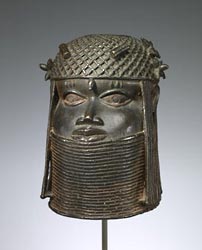MIA Purchases Rare Bronze Masterpiece of African Sculpture
 MIA's newly acquired Benin Head
MIA's newly acquired Benin HeadPhotograph courtesy of MIA
The Board of Trustees of the Minneapolis Institute of Arts (MIA) has approved the purchase of a rare bronze sculpture from the Kingdom of Benin, a pre-colonial civilization once located in what is now southern Nigeria. The sculpture is a bronze memorial head made at the height of the Benin culture, between the mid-sixteenth and mid-seventeenth centuries. Iconic works of this kind are among the masterpieces of the arts of Africa. Now on view in the MIA's recently expanded galleries, the memorial head is displayed among the museum's small but significant Benin holdings, which include a seventeenth-century bronze water vessel in the shape of a leopard, an eighteenth-century carved memorial tusk, and an early nineteenth-century warrior figure recently donated to the MIA.
"This memorial head from the Kingdom of Benin is a magnificent object, representing one of the world's major artistic traditions," said William M. Griswold, Director and President of the MIA. "The acquisition of this masterpiece of African art demonstrates our ongoing commitment to strengthening our holdings in this and, indeed, every collection area with objects of the greatest quality and significance."
Purchased from a European dealer, the memorial head is a major addition to the MIA's collection of African art. The sculpture stands nearly twelve inches high and dates between 1550 and 1650, the so-called "middle period" of Benin art, which many consider the high point of Benin artistic production. The Benin culture is known for creating superb bronze sculptures to honor its Obas (or kings). In this case, the Oba is shown wearing a hat and a multi-strand coral-bead necklace, with another coral bead on his forehead. Brought across the Sahara from the Mediterranean Sea, coral was the sole property of the king and symbolized his power through his control of international trade. Memorial heads such as this were meant to capture the essence of the Oba's power, and were placed on shrines with other important objects. A hole in the top of the head would have held a carved elephant tusk chronicling the activities of the honored Oba.
Few Benin bronze heads remain in private hands, but a number of early (1400-1550) and middle period examples are held in other public collections in this country and abroad. Comparable middle period examples can be found at the Metropolitan Museum of Art in New York, the British Museum in London, and the Museum für Völkerkunde in Vienna.
"This is a great addition to our collection," said Joe D. Horse Capture, acting curator of African, Oceanic, and Native American Art at the MIA. "This head is equal in stature to the greatest masterpieces of our collection of African, Oceanic, and Native American art, and will allow us to better tell the important story of Benin art and culture for our visitors."
The MIA has more than 1,630 objects from Africa. Other African highlights include a terracotta shrine head from the royal city of Ife, a pre-colonial culture of present-day Nigeria, made between the twelfth and fourteenth centuries; a wooden equestrian figure made between the tenth and thirteenth centuries by an artist from the Djenne culture, once located in present-day Mali; and a terracotta seated figure from the Nok culture, a civilization that existed in present-day northern Nigeria from approximately 500 B.C. to 500 A.D.
Resources:
Also in this Issue:
- The Art and History of Brass Musical Instruments
- Maiden Foundry: A Successful Artist-Run Foundry Piloted by Michael Maiden
- The Legend of the Moscow Mule: The Copper Cup that Could
- Steel by Day, Copper by Night: Outside Folk Artist Dave Nally
- MIA Purchases Rare Bronze Masterpiece of African Sculpture
